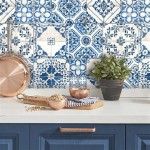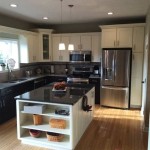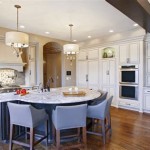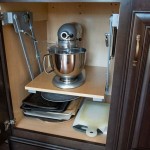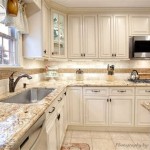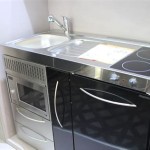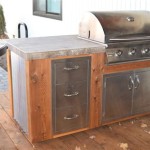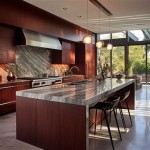Butcher Block Kitchen Island Table: A Comprehensive Guide
A butcher block kitchen island table represents a versatile and aesthetically appealing addition to many kitchens. Combining the functionality of a food preparation surface with the social benefits of a central gathering point, these islands offer a blend of utility and style. Understanding the characteristics, benefits, considerations, and maintenance requirements of butcher block kitchen island tables is crucial for making informed decisions regarding their purchase and care.
The term "butcher block" refers to a specific construction method, not a particular type of wood. It involves joining numerous pieces of wood, typically long strips, end-grain sections, or a combination thereof, to create a solid, durable surface. This construction provides exceptional stability and resistance to warping, making it ideal for heavy-duty use in a kitchen environment.
Butcher block kitchen island tables can range from small, portable units to large, custom-built installations integrated into the overall kitchen design. Their design flexibility allows for various configurations, including those with built-in storage, seating areas, or integrated appliances. The choice of design depends on the individual needs of the homeowner and the existing kitchen layout.
Key Point 1: Materials and Construction of Butcher Block
The quality and performance of a butcher block kitchen island table are heavily influenced by the type of wood used and the construction techniques employed. Hardwoods like maple, walnut, cherry, and oak are commonly selected for their durability, density, and aesthetic appeal. Each wood species possesses unique characteristics that affect its suitability for use in a butcher block.
Maple is a popular choice due to its hardiness, light color, and neutral grain pattern. It's relatively affordable and provides a clean, classic look. Walnut, on the other hand, offers a richer, darker tone and a more pronounced grain, adding a touch of elegance to the kitchen. Cherry is known for its reddish-brown hue and smooth texture, while oak provides a robust and traditional appearance. The selection of wood hinges on the desired aesthetic and the specific requirements of the kitchen.
Three primary construction styles are used in butcher block manufacturing: edge-grain, end-grain, and blended-grain. Edge-grain butcher blocks are constructed with long, parallel strips of wood laid on their sides, exposing the edge of the wood. This construction is known for its affordability and stability. End-grain butcher blocks feature the ends of the wood strips facing upwards, creating a surface that is highly durable and resilient to cuts and scratches. Blended-grain butcher blocks combine edge-grain and end-grain sections, offering a compromise between cost and performance.
The method used to join the wood strips is also critical. High-quality butcher blocks utilize robust adhesives and precise joinery techniques to ensure a strong, seamless bond. The adhesive should be food-safe and resistant to moisture and heat. Inadequate joinery can lead to gaps, cracks, and instability over time. The careful selection of materials and adherence to sound construction principles are crucial for creating a butcher block that withstands the rigors of daily use in a busy kitchen.
Another material consideration is the presence of mineral oil or other food-safe finishes. These finishes are applied to protect the wood from moisture and bacteria, and to enhance its natural beauty. The frequency of re-application depends on the type of finish and the level of use the butcher block receives.
Key Point 2: Functionality and Benefits of a Butcher Block Island
Butcher block kitchen island tables offer a wide range of functional benefits that contribute to a more efficient and enjoyable cooking experience. Their durable surface provides a stable platform for food preparation, making them ideal for chopping, slicing, kneading, and other culinary tasks. The natural hardness of the wood helps to prevent knife damage and provides a comfortable cutting surface.
Beyond food preparation, butcher block islands serve as versatile gathering spaces. They can be used as breakfast bars, casual dining areas, or serving surfaces for parties and events. The warmth and natural beauty of the wood create an inviting atmosphere that encourages social interaction. Islands equipped with seating create a central hub for family and friends to congregate.
Storage is another key benefit of many butcher block kitchen island tables. Base cabinets, drawers, and open shelving can be incorporated into the design to provide ample space for storing cookware, utensils, and other kitchen essentials. This added storage capacity helps to keep the kitchen organized and clutter-free. Some islands include specialized storage features such as knife blocks, spice racks, or cutting board holders.
The portability of some butcher block islands offers additional flexibility. These units can be easily moved around the kitchen or even transferred to other rooms, allowing for greater adaptability in the layout. Portable islands are particularly useful in smaller kitchens where space is limited.
The natural material of butcher block also offers a degree of antimicrobial properties. While not a substitute for proper cleaning and sanitation, the wood contains compounds that can inhibit the growth of certain bacteria. Regular cleaning and oiling help to maintain these properties and ensure a hygienic food preparation surface.
Key Point 3: Maintenance and Care of Butcher Block Surfaces
Proper maintenance is essential for preserving the beauty and longevity of a butcher block kitchen island table. Regular cleaning, oiling, and occasional repairs are necessary to keep the surface in optimal condition. Neglecting these tasks can lead to dryness, cracking, staining, and bacterial growth.
Daily cleaning should be performed with a mild soap and warm water. Avoid using harsh chemicals, abrasive cleaners, or excessive amounts of water, as these can damage the wood. After cleaning, thoroughly dry the surface with a clean cloth. Allowing water to sit on the butcher block can lead to warping and cracking.
Oiling is a crucial part of butcher block maintenance. Food-safe mineral oil or butcher block oil should be applied regularly to replenish the wood's natural oils and prevent it from drying out. The frequency of oiling depends on the level of use and the ambient humidity. Generally, oiling once a month is sufficient for lightly used surfaces, while heavily used surfaces may require more frequent applications. Apply the oil liberally, allow it to soak in for several hours, and then wipe off any excess. This process helps to keep the wood supple and resistant to moisture.
Stains and odors can be removed with a paste of baking soda and water. Apply the paste to the affected area, let it sit for a few minutes, and then scrub gently with a soft cloth. Rinse thoroughly with water and dry the surface completely. For more stubborn stains, a mild solution of vinegar and water can be used. However, avoid using excessive amounts of vinegar, as it can damage the wood.
Minor scratches and cuts can be sanded down with fine-grit sandpaper. Sand lightly in the direction of the wood grain, and then re-oil the sanded area. For deeper scratches or gouges, professional refinishing may be necessary. A qualified woodworker can repair the damage and restore the butcher block to its original condition.
To prevent warping and cracking, avoid placing hot pots and pans directly on the butcher block surface. Always use trivets or hot pads to protect the wood from heat. Additionally, avoid exposing the butcher block to extreme temperature fluctuations or prolonged periods of dryness. Maintaining a stable humidity level in the kitchen can help to prevent these problems.
Finally, avoid using the butcher block as a cutting surface for raw meat or poultry without proper sanitation. Always wash the surface thoroughly with hot, soapy water after contact with raw meat, and consider using a separate cutting board for these items to minimize the risk of cross-contamination. Proper maintenance and sanitation are essential for ensuring the safety and longevity of a butcher block kitchen island table.
In addition to the above key points, other factors can influence the choice and care of a butcher block island. The overall kitchen style, budget constraints, and personal preferences will all play a role in the decision-making process. Researching various options, comparing prices, and consulting with experienced professionals can help to ensure a satisfactory outcome.

Kitchen Island Custom Butcher Block With Option For Seating Dining Table Storage Donna Etsy

Kitchen Island Butcher Block Table Wood Cutting Reclaimed Rustic

Kitchen Island Butcher Block Table Modern Mid Century Wood Bohemian Dining Etsy

The Monogrammed Butcher Block Kitchen Island Arcadian Cottage

Kitchen Island Custom Butcher Block With Option For Seating Dining Table Storage Donna Etsy

Installing Butcher Block On A Kitchen Island Sew Woodsy

Custom Wood Kitchen Islands With Seating Storage Table Marble Tops

Trinity Butcher Block Island Overstock

502 416 Color Story Black Butcher Block Kitchen Island Powell

Project Rolling Kitchen Island Woodworking Blog Videos Plans How To

